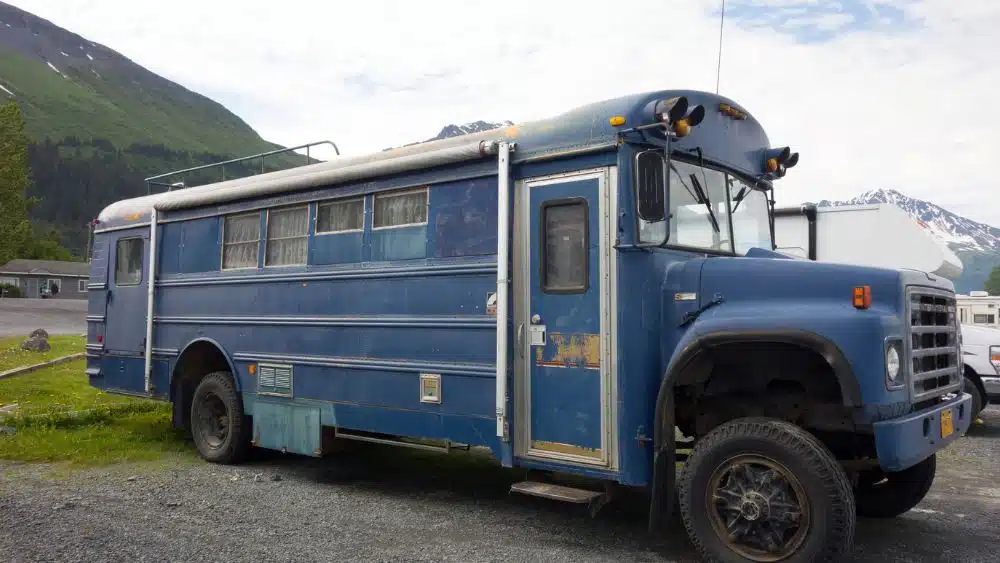Thinking of moving into a school bus full-time? Converting a shuttle bus into a mobile home can be confusing, time-consuming, and even costly.
Before you dive right into 24/7 skoolie life (the term used for school buses converted into tiny homes), here are a few points to consider.
Overall Cost
Expenses can vary, but the cost ranges between $9,000 and $30,000. Depending on the size of the bus, materials, tech upgrades, home comforts, professional help, and safety measures, these costs can be even higher.
The next to consider is your overall budget. With a budget in mind, you’ll be able to properly plan (which includes funds for surprise expenses). The biggest way to blow through a school bus conversion is a lack of foresight in the plan. And if you want a plan that’ll make the entire process less stressful, here’s what you need to know.
Skoolie Conversion Breakdown
Taking the steps to transform a bus into a tiny home is a grand adventure with some serious dedication. Keep in mind that any bus that drives from one place to another is considered a shuttle bus (think, standard long and short school buses). Regardless, follow the steps below on any type of bus you’re aiming to convert.
The Bus

To begin, you’ll need a vehicle to convert. How much you’ll pay for the bus depends on the vehicle’s state and age—and if parts of it have been demoed or retrofitted to a conversion—plus, any state or local taxes based on your location. Overall, the average price for a school bus in working condition can range from $3,500 to $11,000. And, in most states in the U.S., you’ll have to pay taxes on that vehicle purchase. For example, if there’s an 8.5% tax on car purchases, you’ll have to pay $850 in taxes on a $10,000 shuttle bus.
Registration and Insurance

Like any other car you drive, the shuttle bus must have a title and get registered. Much like tax fees, the cost of the title and registration depends on where you live, but it’s estimated that the costs run between $40 to $250 per year. From there, you’ll need insurance to protect against accidents or emergencies, and the policy prices are between $1,000 to $3,000 per year (based on 140 days of usage, so the cost can vary further).
Demolition and Renovation

Now that you have a shuttle bus, you’re ready to move onto the demolition stage. Demolishing an interior can be rather involved, so it’s best to be mindful of the costs in this process as it will make the renovation stage much smoother. In this article, we’ll assume you are going to remove all of the contents of the bus and start from scratch. This includes removing old panels, flooring, outdated fixtures, or hardware that’s in disrepair.
You might be able to demo the entire van by yourself or with friends and family (go, you!), or you might need demolition services. In that case, a demolition service can cost between $2 and $10 per square foot (just like a traditional home). For example, short buses can be 20 to 25 feet in length, making a demolition cost around $2,000 to $4,000. Note: you’ll also incur a separate fee for junk removal. Keep this in mind, as you’ll need a separate hauler and dumpster depending on how much you need to dispose of. A hauler cost can run from $200 to $500.
Construction, Electrical, and Repairs

Welcome to the next stage: Renovations. There could be a lot happening under the hood of the bus, and vehicle repairs can vary wildly, so keep the budget open for small tasks as low as $50 to large-scale fixes at $1,000 to $10,000 (especially if it is engine related).
From there you’ll move on to installing electricity. Electricians will charge an hourly rate (anywhere from $50 to $150), and wiring jobs can fall between $150 to $600. Odds are, you’re probably also considering a generator or solar panels to take off-the-grid living to bigger heights. Generators can begin at $2,000 (and go up to $23,000), plus an installation fee (another $300 to $10,000). Solar panels can range anywhere from $1,000 to $10,000 depending on the size of the bus and your needs. Add in extra costs—up to $2,000—for a power bank setup.
Construction—like for a standard home—includes insulation ($.075 to $5 per square foot), flooring ($2 to $6 per square foot), and walls ($200 to $2,000).
Plumbing, Heating, and Cooling

Water and propane access are vital for RV living. Depending on your needs—i.e., shower, toilet, and sinks—a plumber costs $40 to $225 an hour. But installations can be more expensive ($300 to $1,850). Additionally, propane can run from $200 to $800 to install a new fuel line. As for cooling down the bus, air conditioners can vary in price ($200 to $1,500), and heating has many options including propane heaters ($80 to $500) and wood stoves ($100 to $1,000).
Kitchen and Bathroom

RV shower stalls cost between $300 and $1,200, while kitchen sinks can go for $125 to $500. And if you’re adding a toilet—typically self-contained devices emptied by hand—there are relatively inexpensive options from $100 to $200, but other models can be up to $2,000. Water heaters can add to the renovation budget, clocking in at up to $1,000.
Having all your home’s comforts, like kitchen appliances, can level up any tiny space. A fridge can be as low as $90 or a few thousand dollars depending on the size and requirements you need. While a stove (or a mix of hot plates and a kettle), can range from $75 to $700, depending on the appliances. Perhaps you want to throw a washer/dryer into the mix too. That can run from $700 to $1,800.
Furnishings, Lighting, and Decor

The furniture in your new home should be comfy, cozy, and functional. While you want it to reflect your personality, your minimalist furnishing needs to be multi-purpose and might need to be a custom size to boot. The standard bed and mattress combinations range from $400 to $2,000, with prices rising if you’re seeking custom storage options as well. Additional sleeping add-ons like mattress pads can run a few hundred dollars.
Lounging is important in the home bus, so loveseats or single seats (like cushy floor cushions) can go from $100 to $600. Add in pillows and throws for more coziness—and ambiance—for $20 to $200. Remember, you’re living in a smaller space, so decor items and paint won’t be as spendy. Paint is typically priced at $12 to $35 per gallon. A few art pieces, like a woven piece of wall art or a message board, can cost between $10 and $100. Finally, lighting is a key point for daily living, enhancing mood and safety. Once the home is wired, add fixtures and/or recessed lighting. Simple sconces or recessed lights cost between $40 to $250, depending on the size, style, and finish.

Stephanie Valente is a Content Director and Editor in Brooklyn, NY. She’s previously held writing and social media positions at Barkbox, Men’s Journal, and currently works at a full-service advertising agency. She’s a self-confessed home and design enthusiast. Stephanie is an award-winning poet and fiction writer. When she’s offline, you can find her taking a yoga class, running, hanging out with her rescue dog Pepper. Find her on stephanievalente.com.
 10 Best State Parks in Minnesota
10 Best State Parks in Minnesota